The salvation of any Island family with needle-averse children in recent years has been the “flu mist,” an alternate form of the yearly influenza vaccine that gets squirted into the nose rather than needled into the arm.
For Oliver the coming of the mist was transformative; flu vaccine time was still an anxious time of the year, mostly because being in a hall filled with other people about to get a needle is like sitting in the waiting room of a particularly brutal airport. But the anxiety was manageable, and thus not a source of seasonal dread.
So much so that we secured permission from Dr. Heather Morrison, Chief Public Health Officer, to allow Oliver to continue to receive the mist into adulthood.
Which is why, when it was announced in September that the flu mist would not be available in Canada this season, due to shortages, my chest tightened.
After confirming with Dr. Morrison that the mist was out, we decided to follow her advice to look into receiving the flu shot from our family doctor, a setting where we could be more in control of the environment, and where Oliver would be more comfortable.
Fortunately we have a family doctor, and our family doctor has an exceptionally talented nurse, Cheryl, who Oliver’s known for many years, and with whom he has a good relationship.
So we made an appointment for this morning.
I chatted with Cheryl on the phone before we came into the office to establish a shared understanding of the challenge ahead.
And then casually mentioned to Oliver, after breakfast, that we had an appointment with Cheryl to get the flu shot (reminding him of her excellent bedside manner, and problem-free blood draw this summer).
And we headed into the office for 10:00 a.m.
About 10 minutes before giving Oliver the shot, Cheryl came out into the waiting room and applied some numbing cream to the injection site; once Oliver’s arm had a chance to numb up, we went into an exam room, Oliver hopped up on the exam table, and he got his flu shot.
No fuss, no muss.
Well, some preemptive muss. And a lot of hang-wringing and worry on my part and Catherine’s.
But Oliver rose to the occasion. Cheryl rose to the occasion. And Oliver’s been vaccinated.
Onward!
The weather has turned over the last week from “late autumn” to “early winter,” and with the turn came the first snow and ice. This was the scene that Oliver and I were greeted with on our way out the door this morning: the purple phlox flowers in our front garden downed by the weather.
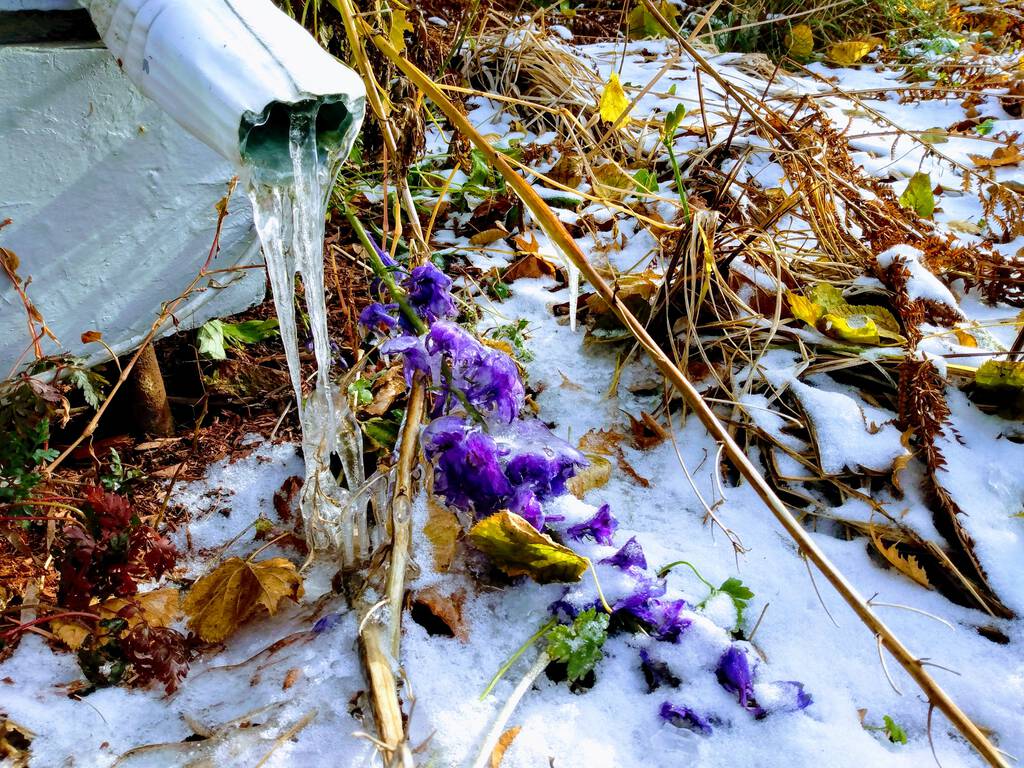
If you set aside your “exactly how is it that this millennial couple have their own helicopter?!” feelings, this series of videos covering their trip from Buffalo to Newfoundland is breathtaking.
On Monday my friend Ton posted a brief update on his blog:
Arrived in Brussels for Edgeryders SF authors and economists meetup. Looking forward to it.
Like a lot of blogging, this post concerned travel: in this case, a train trip (I’m hopefully assuming, given the distance involve) from Amersfoort to Brussels).
I’ve been thinking a lot about the importance of surfacing the carbon impact of our daily activities; travel, especially, is important to focus on, both for its significant contribution to total emissions (48% here in PEI) and because travel is something that we have atypical agency in reducing (it’s easy to decide not to fly to Europe; deciding not to heat my home is harder).
Anecdotal evidence from my personal experience suggests that paying continuous partial attention to consumption can have a positive effect on reducing consumption: even absent any other drivers, the mere fact of observing, it seems, is helpful.
Which leads me to an idea.
HTML has a helpful extensibility that allows data to be embedded in web pages using “data attributes.”
What if Ton’s post embedded the carbon impact of his travel, and perhaps his mode of travel, turning this:
<p>Arrived in Brussels for Edgeryders SF authors and economists meetup. Looking forward to it. </p>
into this:
<p><span class="emissions" data-co2="7.5" data-travelby="train">Arrived in Brussels</span> for Edgeryders SF authors and economists meetup. Looking forward to it.</p>
(the CO2 emission of a train trip from Amersfoort to Brussels are estimated to be 7.5 km by EcoPassenger).
To the casual reader of the blog post, nothing would change.
But with a little JavaScript, a curious reader could pull out the carbon impact of the activities described in the post:
var emissions = document.querySelector('.emissions');
console.log(emissions.dataset.co2);
Adopting this as a standard practice would be beneficial for two reasons:
- For the blog author, forming a habit of documenting the climate impact of travel could be helpful in understanding more about (and coming face-to-face with) the accumulating effect of travel habits.
- For the researcher, being able to extract climate impact data from blog posts could prove a useful data surface, and could spur the development of browser-based tools that could use this information in interesting ways (i.e. change the colour of the browser toolbar based on the carbon impact of a post).
To experiment with this, I’ve started by marking up a blog post of my own, adding two chunks of “carbon markup”:
<p><span class="emissions" data-co2="1460" data-travelby="airplane">We flew Charlottetown-Montreal-Vancouver today</span>; we didn't leave Charlottetown until 4:00 p.m. and we're in bed in Vancouver at 11:00 p.m. Such is the wonder of the rotating Earth.</p>
and:
<p>We found our way to the SkyTrain, <span class="emissions" data-co2="0.067" data-travelby="transit">navigated to the Yaletown station</span>, walked up the hill to Burrard. And are now ensconced inside The Burrard.</p>
I can then extract the carbon impact of that post’s travels with this JavaScript:
var emissions = document.querySelectorAll('.emissions');
var total_co2 = 0;
emissions.forEach(function(trip) {
total_co2 += parseFloat(trip.dataset.co2);
});
alert("Total CO2 from this post was " + total_co2 + " kg.");
which displays:
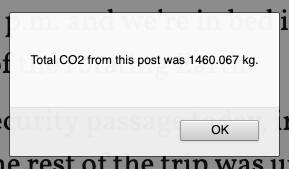
I’ve no idea whether this methodology is the best methodology, but I like the fact that it’s simple and doesn’t take much expertise to inject into a post; it would certainly be possible to add structured metadata to a post using JSON or XML, but that would add a perhaps-unnecessary level of complexity. And for this to work, it has to be easy.
Thoughts?
When we opened the door to our apartment in the Cannaregio district of Venice on December 3, 2010, here’s the scene we were greeted with:
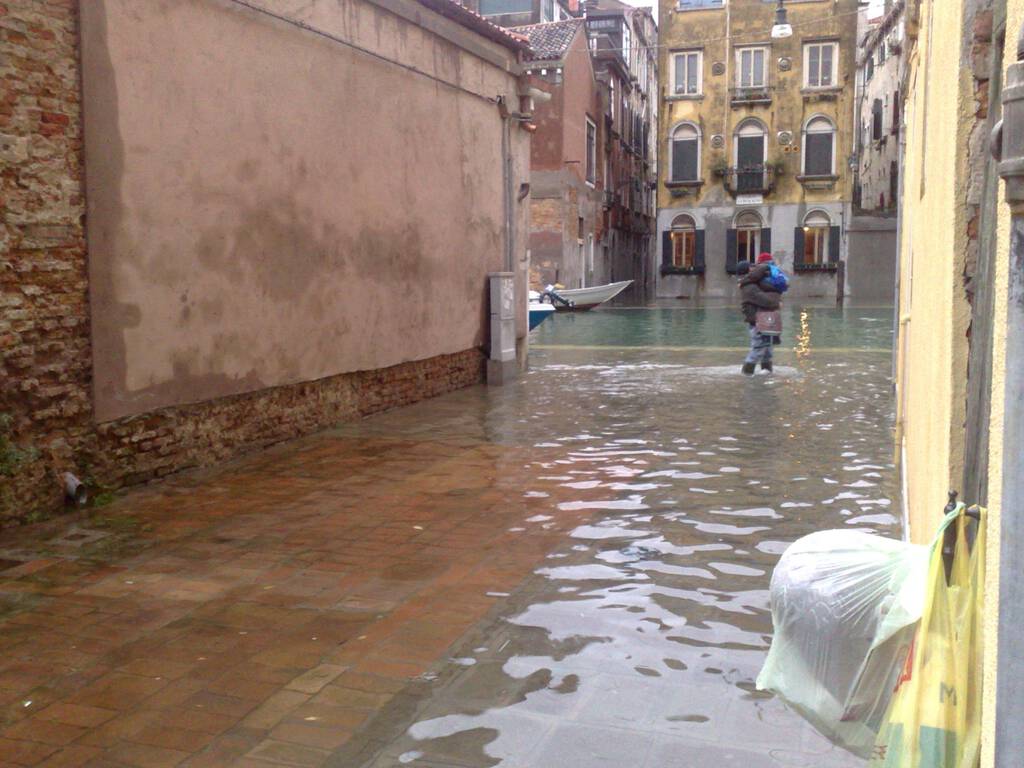
Historic water level data from Venice shows that at 8:00 a.m. that day the water was at 131 cm.
An hour later the water level was at 136 cm — the high water mark for the day, and the third-highest water level recorded in 2010 — and it was starting to come in our front door:
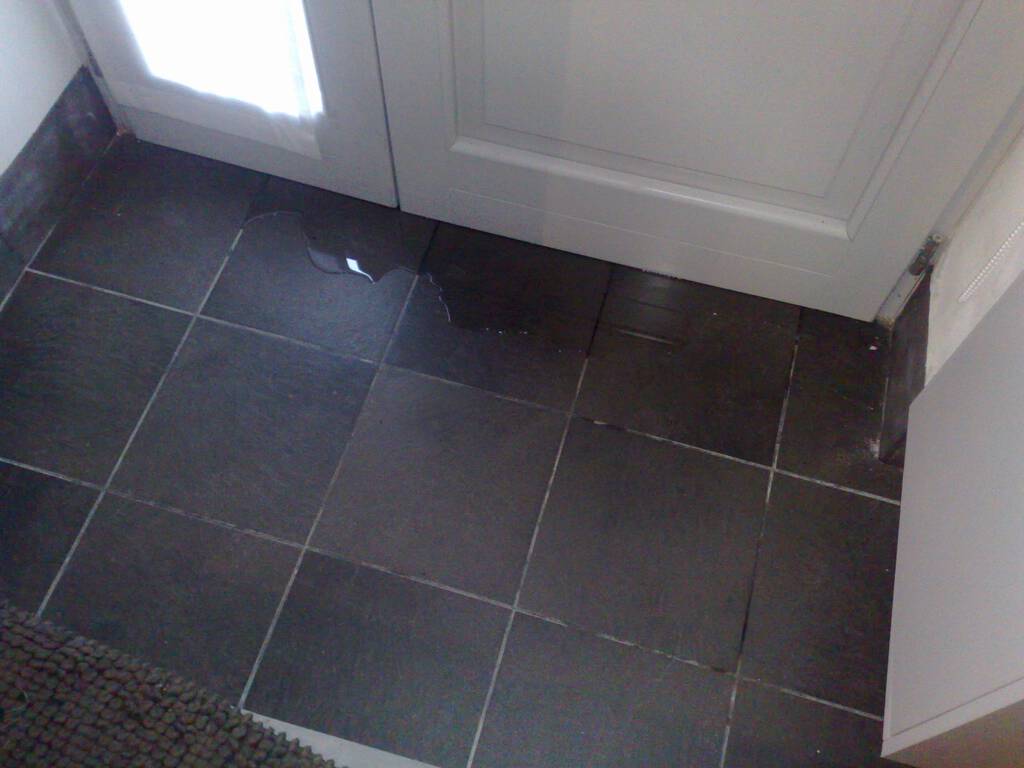
By 12 noon the water level had dropped to 84 cm and the street was empty of water (that’s Catherine and Oliver under the umbrellas):

High water in Venice today was 144 cm as the city received its highest tide in 50 years.
In the middle of the April provincial general election campaign here on Prince Edward Island I was having a chat with a friend: he related the story of the incumbent Liberal MLA coming to his door to look for his vote and, when learning that he would not be receiving it, he asked why.
My friend suggested he start by looking at the Liberal plan to make driver’s licenses free, a plan funded by revenue from the carbon tax.
This policy amounted to a kind of reality Gerrymandering where, instead of rearranging district boundaries to suit their political needs, the Liberals instead attempted to rearrange the universe such that an incentive to drive could be construed a carbon mitigation action.
I’ve said many times since that Liberal government was defeated that this move was the root cause of their downfall: Islanders are not stupid, and while we won’t look askance at funding for a rink in the district, an outright attempt to convince us that up is down and down is up is seen through for what it is.
The truth of this was reinforced at an October meeting of the Special Committee on Climate Change where every reference to the driver’s license foolishness was greeted universally with a hearty ironic guffaw. I think I even detected some ironic sighs from the Liberal benches.
All of which leads me to be extra-especially happy with the announcement that the government will reinstate fees for driver’s licenses, and instead use the $5 million in funds to support active transportation projects.
Bravo.
My friend Dave does a regular segment on CBC’s Island Morning called The Things We Do For Love, wherein he interviews people about their esoteric passions.
Tuesday morning Dave dipped into Pen Night.
Things don’t get much more esoteric than pen geeks talking about pens, inks and paper.
I’ve attached the MP3 that aired this morning.
My friend Elmine, in her post Leer weer langzaam denken, passes on a piece of advice from Frank:
Belangrijk nog om te melden is de tip die ik van Frank kreeg: ook met vijftien minuten per dag kom je verder in een boek. Die tip heeft me in beweging gekregen om aan een eerste boek te beginnen. En wat gebeurd er vervolgens? Ongemerkt lees ik nu zo weer een uur of langer achter elkaar.
Or, machine-translated:
Another important thing to report is the tip I got from Frank: even with fifteen minutes a day you continue in a book. That tip got me moving to start a first book. And what happens next? Unnoticed, I now read for an hour or more in succession.
I’ve found that if I simply make an effort to scatter books around my home and office, I’ll be more likely to pick them up and read them.
And if I pick them up and read them I’m more likely to keep reading them, for far longer than I’d set out to.
This proves a far more effective “I should read more” strategy than trying to conjure up a perfect reading nook and booking out specific reading time.
Put another way: you can’t read a book that’s not in front of you.
As in 2017, I’m late to put away the garden hose. But I got a better jump of everything else, including Oliver’s bicycle, which I moved inside yesterday, just in time. The snow has mostly melted now, mid-morning, but it’s clear the season has turned a corner.
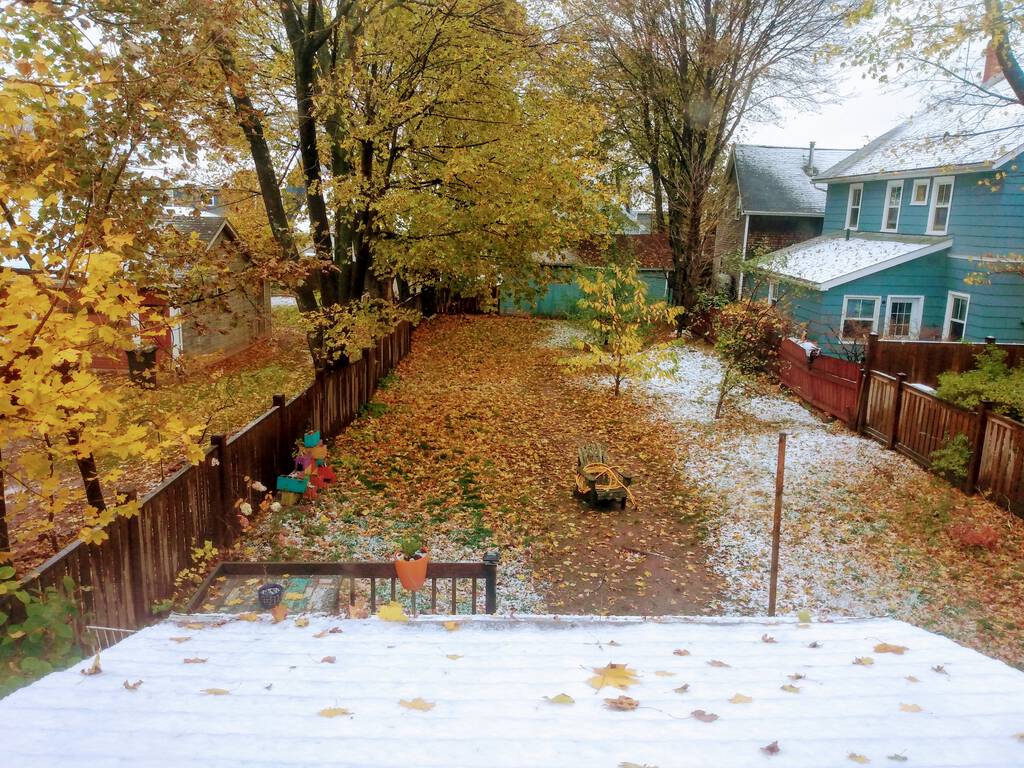
My friend and collaborator Brenda Whiteway is delivering the November Island Studies Lecture at the University of PEI on November 19, 2019 at 7:00 p.m. in the Faculty Lounge in Main Building:
The passage of time, transitions in nature, and shifting patterns of life have been recurrent themes in Brenda Whiteway’s creative work. The White Sands PEI Shoreline Project is a further exploration of these themes through paintings, drawings, photographs, and mixed-media of a small coastal area in White Sands, PEI, which has personal significance but resonates on a universal scale. The site originally belonged to her maternal grandparents who had a subsistence farm and fished off the Northumberland Strait close to Pictou Island. Brenda has been observing, recording, and researching the area’s weather patterns, light, tidal shifts, flora and fauna, history, and cultural ecology. For her, this is a metaphoric petri dish through which cultural and climactic shifts may be viewed on an intimate scale and expressed creatively. Capturing the elusive qualities of the seasons through various art mediums while plants bloom and fade, tides shift, earth freezes and thaws, and the sky reveals its many moods is an attempt to capture the genius loci of an area the artist holds dear.
There are fewer more thoughtful, creative people than Brenda, and you should plan to attend.
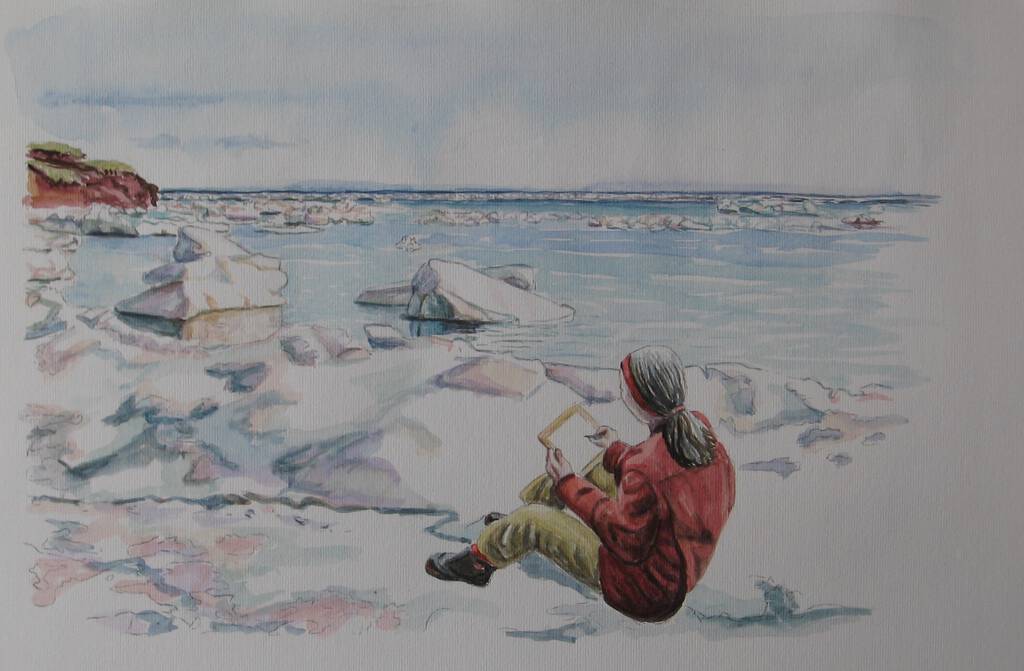
 I am
I am